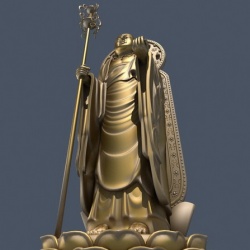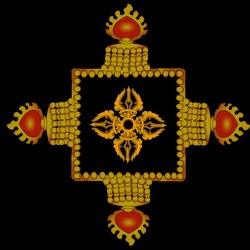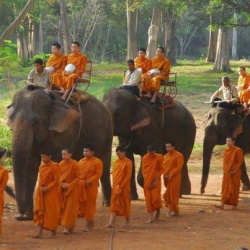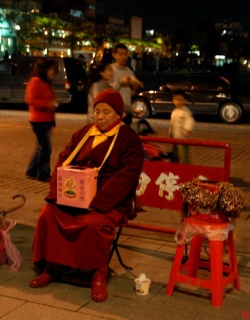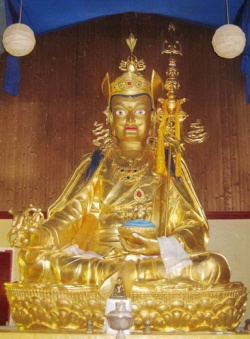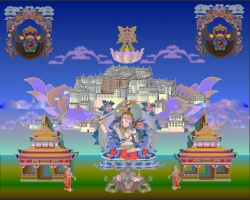Dhyani-Bodhisattva
Dhyani-Bodhisattva (Sanskrit) [from the verbal root dhyai to meditate, contemplate + bodhisattva he whose essence is bodhi (wisdom)] A bodhisattva of meditation or contemplation; the sixth in the descending series of the Hierarchy of Compassion, the mind-born sons of the dhyani-buddhas.
"There is a dhyani-bodhisattva for this globe, and also for each of the three globes which precede this globe on the downward arc, and likewise a bodhisattva for each of the three globes which follow this globe on the upward arc -- one bodhisattva for each. This dhyani-bodhisattva is the spiritual head of the spiritual-psychological hierarchy of each globe. . . . Our dhyani-bodhisattva is the Wondrous Being, the Great Initiator, the Silent Watcher of our globe
Dhyani Bodhisattva: dhyani bodhisattva "of meditation"; Bodhisattva's and Buddha's "of meditation"; a Bodhisattva or Buddha, such as Amitabha (Amida in Japanese), who appears to the eye of contemplative vision, but is not accessible in a historical form.
The Dhyani-Bodhisattva (Sambhoga-Kaya) (He whose essence is Perfect Knowledge).
According to the Northern Buddhist school, there are both mortal and celestial Bodhisattva.
A mortal Bodhisattva is one who has manifested himself on earth in human (manushi) form, in a series of incarnations, until such a time as he has acquired sufficient merit and enlightenment (bodhi-jnana) to receive Buddha-hood.
Like Gautama Buddha in his incarnation of the arhat Sumedha, the Bodhisattva may have been, in a former re-birth, an arhat bent on his own salvation who, becoming inspired with the desire for Bodhi in order to save mankind, renounced his arhat-ship.
It is unusual, however, according to M. de la Vallee Poussin, for the future Bodhisattva to have been an arhat. In the first stage, he usually becomes a candidate for Bodhisattva-hood by the practice of the six Paramitas, or Transcendent Virtues through which he is to accumulate merit.
The second stage of the Bodhisattva is reached when he becomes conscious of the desire for Buddha-hood. This illumination is called 'Bodhi-chitta' The aspirant, now aware of his wish for Bodhi, must make the vow that he will re-enter, or continue to remain in, the world of suffering for the sole purpose of saving mankind.
This, the Great Vow of the Bodhisattva, however, does not make the aspirant a Bodhisattva. It is only when he enters on the Path of Bodhi that he reaches the third stage, at which he becomes a Bodhisattva.
But in order to reach the ultimate goal of Buddha-hood, it is necessary for the Bodhisattva, in one of his incarnations, to meet the reigning Buddha of that kalpa, or epoch, and acquaint him with his desire for Buddha-hood. The Tathagata will then look forward through the future re-births of the Bodhisattva and announce his eventual triumph.
The Bodhisattva, now aware of his future Buddha-hood, enters on a stage 'from wbich there is no return'. He must practise the ten Paramitas which make a Buddha, and continue to accumulate merit in his different re-births, always bearing in mind that his sole aim in becoming a Tathagata is to save all creatures from suffering.
When the future Buddha has reached the last stage of Bodhisattva-hood, and resides in the Tushita heaven, he is free to decide whether he will pass through the intermediary stages of the thirteen Bodhisattva heavens to reach Nirvana, or will descend to earth and become a mortal Buddha, after which he will enter directly into Nirvana.
The only Manushi-Bodhisattva that is met with in Buddhist art is Maitreya, who has two representations: as Bodhisattva, his present form in the Tushita heaven, and as Buddha, the form he will take when he descends to earth as Manushi-Buddha. (PI. xv, figs, a and b.) All the other Bodhisattva representations are of Dhyani-Bodhisattva.
The Dhyani-Bodhisattva is celestial and is the second 'body' (kaya) in the Tri-kaya or Northern Buddhist Trinity. He is believed to dwell in the Rupadhatu heaven in the body of absolute completeness (Sambhoga-kaya), in a state of ' reflected spirituality ', that is to say, that it is in this form that the Dharma-kaya (DhyaniBuddha) reveals himself to the Bodhisattva or future Buddhas in the Tushita heaven. Although, according to the Buddhist writings, the name is legion, there are comparatively few dhyani-bodhisattva represented in Buddhist art, and these may be divided into two groups — of five and of eight.
The five dhyani bodhisattvas correspond with the five Dhyani-Buddhas and differ in many respects from the other celestial Bodhisattva. They are: Samantabhadra, Vajrapani, Ratnapani, Avalokitesvara, and Visvapani.
Those belonging to the group of eight are found in Northern Buddhist temples on either side of an important divinity. The gods on the right are: Avalokitesvara, Akasagarbha, Vajrapani, and Kshitigarbha, while on the left are: Sarva-nivaranavishkambhin, Maitreya, Samantabhadra, and Manjugrl.
Each Dhyani-Bodhisattva in the group of five is evolved, according to the system, by his Dhyani-Buddha. He is a reflex, an emanation from him; in other words, his spiritual son. Certain Northern Buddhist sects that interlink the dogmas of the Tri-kaya and the Tri-ratna look upon the Dhyani-Bodhisattva as the active creator, Sahgha, product of the union of Buddha (mind) and Dharma (matter). According to the system of Adi-Buddha, the Dhyani-Bodhisattva receives the active power of creation from Adi-Buddha through the medium of his spiritual father, the Dhyani-Buddha.
The Dhyani-Bodhisattva of this group of five have a definite place in the Mahayana system and for a special purpose, that is, to evolve, each in his turn, from his own essence, a material and perishable world over which he is to preside until the advent of the Manushi-Buddha of his cycle. At the death of his mortal Buddha, he must continue the work of the propagation of Buddhism until his successor creates a new world.
Three of the Dhyani-Bodhisattva have created worlds, and are now engrossed in worshipping Adi-Buddha, or, according to some, have been absorbed into Nirvana. The present world is the fourth, and there is the fifth yet to come.
The first world was created by Samantabhadra (Dhyani-Bodhisattva). His spiritual father Vairocana (Dhyani-Buddha) manifested himself on earth in the form of Manushi-Buddha, Krakucchanda. In the same way we have:
The second world.
Dhyani-Bodhisattva: Vajrapani.
Dhyani-Buddha: Akshobhya.
Manushi-Buddha: Kanaka-Muni.
The third world.
Dhyani-Bodhisattva: Ratnapani.
Dhyani-Buddha: Batnasambhava.
Manushi-Buddha: Kasyapa.
The fourth world is the present one, created by Avalokitesvara (Dhyani-Bodhisattva). His spiritual father, Amitabha (Dhyani-Buddha), manifested himself on earth in the form of Gautama-Buddha, Sakya-muni. The Northern Buddhists believe that Avalokitesvara continues the work that Gautama Buddha began, and, in order to do so, incarnates himself in each successive Dalai-Lama of Lhasa.
Five thousand years after the death of Gautama Buddha, Maitreya will appear as Manushi-Buddha in the fifth world, which will be created by VisVapani (fifth Dhyani-Bodhisattva), who dwells in the Bupadhatu heaven waiting for the fifth cycle, when he will receive active power of creation and evolve the fifth world.
The Dhyani-Bodhisattva is represented dressed in princely garments and wearing the thirteen precious ornaments, which are: a five-leaved crown, an ear-ring, a closely fitting necklace, an armlet, a wristlet, a bracelet, an anklet, a shawl for the lower limbs and one for the upper; a garland reaching to the thigh and another to the navel; a girdle, and a sash. In the central leaf of the five-leaved crown is usually a small image of his Dhyani-Buddha or spiritual father. The hair is drawn up in mitre shape, forming the ushnisha, and may be decorated with jewels. He generally has the urna on the forehead.
If the Dhyani-Bodhisattva is in a sanctuary with his Dhyani-Buddha he is always standing, but is represented seated when in his own chapel.
The first Dhyani-Bodhisattva mentioned in the Buddhist scriptures is Manjus , personification of Wisdom. The second is Avalokitesvara, personifying Mercy, while the third is Vajrapani, bearer of the thunderbolt (vajra), personifying Power. These three form a very popular triad — the first triad in Northern Buddhism.
The Dhyani-Bodhisattva may be in company with their Sakti in yab-yum attitude, as well as the Dhyani-Buddhas, who, in that case, are represented like the Bodhisattva and are called ' crowned Buddhas'.
The Chinese claim four Dhyani-Bodhisattva: Ti-tsang (Kshitigarbha), who presides over the earth; Kwan-yin ( Avalokitesvara) , who presides over water and symbolizes Mercy; Pu'hien (Samantabhadra), who presides over fire and symbolizes Happiness; Wen-shu (Manjusri), who presides over ether and symbolizes Wisdom.
These are also practically the only Bodhisattva popular in Japan. The Bodhisattva in both China and Japan may be either dressed like a Buddha with only the high and complicated ushnisha, indicating his rank, or richly dressed and wearing many ornaments, which, however, do not correspond to the traditional thirteen ornaments quoted above, (v. Kwan-yin and Kwan-non.)
